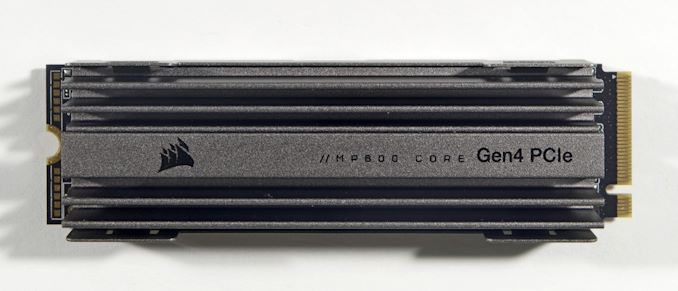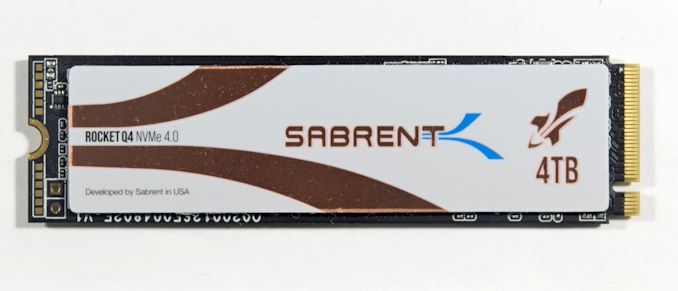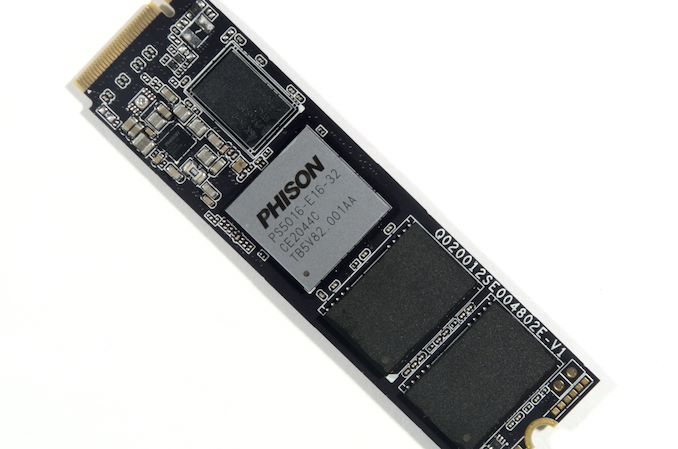Sabrent Rocket Q4 and Corsair MP600 CORE NVMe SSDs Reviewed: PCIe 4.0 with QLC
by Billy Tallis on April 9, 2021 12:45 PM EST
Three years ago, a new variant of flash memory hit the SSD market which stores four bits of data in each memory cell called QLC. This new QLC NAND flash memory offered 33% better bit density compared to three bits per cell with mainstream TLC NAND. QLC initially arrived as a low-end alternative that provides better density and price, but the trade-off has been worse performance (and endurance). So far the use of QLC NAND has always meant that any drive with QLC belongs in an entry-level market segment, competing against the cheaper TLC NAND SSDs that cut corners on other components. But as more SSD vendors adopt QLC NAND in a wider range of products, some are starting to challenge the assumption that QLC is only for low-quality bargain products.
Prime Time QLC SSDs
Sabrent and Corsair are two very familiar brands that market SSDs based on reference designs from SSD controller vendor Phison. Both brands have followed Phison's lead in using QLC NAND for M.2 NVMe SSDs. The latest and greatest QLC solution from Phison uses its E16 SSD controller, which was the first consumer SSD controller to support PCIe Gen4. The Sabrent Rocket Q4 and Corsair MP600 CORE we are reviewing today are part of the first generation of PCIe 4 SSDs to use QLC NAND: an almost paradoxical combination of a high-end PCIe 4.0 connectivity with low-end QLC NAND. The question to answer is whether if QLC NAND is moving up market into mainstream or high-end products, or is it just PCIe 4.0 support now trickling down to low-end higher-capacity drives? This is what we set to find out with this review.
Corsair MP600 CORE
Many aspects of the Corsair MP600 CORE's spec sheet look pretty high-end. The drive comes with basically the same heatsink as Corsair's high-end TLC drives, albeit in a slightly different color.
Peak performance ratings are close to 5GB/s for reads and 4GB/s of writes, making PCIe 4.0 a necessity to hit those numbers.
| Corsair MP600 CORE Specifications | |||||
| Capacity | 1 TB | 2 TB | 4 TB | ||
| Form Factor | M.2 2280 PCIe 4 x4 with heatsink | ||||
| Controller | Phison E16 | ||||
| NAND Flash | Micron 1Tbit 96L 3D QLC | ||||
| DRAM | DDR4 | ||||
| Sequential Read (MB/s) | 4700 | 4950 | |||
| Sequential Write (MB/s) | 1950 | 3700 | 3950 | ||
| Random Read IOPS (4kB) | 200k | 380k | 630k | ||
| Random Write IOPS (4kB) | 480k | 580k | |||
| Warranty | 5 years | ||||
| Write Endurance | 225 TB 0.1 DWPD |
450 TB 0.1 DWPD |
900 TB 0.1 DWPD |
||
| MSRP | $154.99 (15¢/GB) |
$309.99 (15¢/GB) |
$644.99 (16¢/GB) |
||
The five-year warranty and pricing around $0.15/GB are also indicative that the MP600 CORE isn't exactly entry-level. But on the other hand, the write endurance rating of just over 0.1 drive writes per day is much lower than the usual 0.3 DWPD expected from mainstream consumer SSDs. There are also some unimpressive performance metrics, especially for the smallest 1TB capacity.
Sabrent Rocket Q4
Sabrent's published specs for their Rocket Q4 are quite a bit less detailed, but follow the same general pattern:
| Sabrent Rocket Q4 Specifications | |||||
| Capacity | 1 TB | 2 TB | 4 TB | ||
| Form Factor | M.2 2280 PCIe 4 x4 (optional heatsink) |
||||
| Controller | Phison E16 | ||||
| NAND Flash | Micron 1Tbit 96L 3D QLC | ||||
| DRAM | DDR4 | ||||
| Sequential Read (MB/s) | 4700 | 4800 | 4900 | ||
| Sequential Write (MB/s) | 1800 | 3600 | 3500 | ||
| Warranty | 1 year (5 with registration) | ||||
The Phison E16 controller was originally a very successful bid to be first on the market with a controller supporting PCIe 4.0: Phison ended up having a monopoly on PCIe 4.0 SSDs for over a year, and even some SSD brands that don't routinely use Phison controllers brought out new flagship models based on this controller. But now the successor E18 controller is shipping, as well as competing top of the line PCIe 4.0 drives from both Samsung and Western Digital with their own custom controllers. That leaves the E16 as an outdated part, with performance that is no longer sufficient for a flagship model, and power consumption that is quite high. The E16 is manufactured on 28nm whereas all the other PCIe 4.0 SSD controllers are build on more advanced nodes like 12nm. This means that the E16 is ripe for that cheaper PCIe 4.0 market, which makes sense when adding in some high density QLC.
All that being said, the E16 controller is still a step up from Phison's very successful E12 PCIe 3.0 SSD controller. These PCIe 4.0 controllers are backwards compatible with PCIe 3.0, so even in a system that only supports PCIe 3.0, a drive based on the Phison E16 (like the ones we are testing today) is a bit faster than the E12.
It doesn't currently make sense to pair QLC NAND with the expensive flagship E18 controller, but the E16 has found a second life as Phison's more affordable and mature Gen4 controller when paired with QLC. One consequence of replacing E12+QLC drives with E16+QLC designs is that the E16 controller is physically larger than the compact E12S version's package, and that size difference means the 8TB models cannot yet move up to the E16 controller due to lack of space on a M.2 2280 PCB. That's a shame, because the best showings for QLC NVMe SSDs have been at the largest capacities where huge SLC caches and the highest possible degree of parallelism allow drives to mostly overcome the worst downsides of QLC NAND.
The Competition
In this review, we're comparing the 4TB Sabrent Rocket Q4 and 2TB Corsair MP600 CORE against a variety of other SSDs, from low-end QLC SATA SSDs to high-end gen4 drives with TLC NAND. Particularly interesting points of comparison include:
| Intel SSD 670p | PCIe 3.0 x4 | SM2265 | QLC | |
| Sabrent Rocket Q | PCIe 3.0 x4 | Phison E12S | QLC | |
| Corsair MP400 | PCIe 3.0 x4 | Phison E12S | QLC | |
| Samsung SSD 980 | PCIe 3.0 x4 | Samsung Pablo | TLC | DRAM-less |
| WD Blue SN550 | PCIe 3.0 x4 | WD Custom | TLC | DRAM-less |
| Seagate FireCuda 520 | PCIe 4.0 x4 | Phison E16 | TLC |













60 Comments
View All Comments
ZolaIII - Friday, April 9, 2021 - link
What's the purpose of those? I mean I recently bought MP600 1 TB for the price of MP600 Core same capacity. I didn't bought it for it's speed but it's TBW endurance which is by the way twice as MP600 Core 4GB.This doesn't have any market place in my opinion when you can buy a drive with same controller and same 96 layer but TCL NAND for a same price or just a little bit more money.
SarahKerrigan - Friday, April 9, 2021 - link
Yeah, right now really the only sweet spot for QLC is at 4TB.powerarmour - Saturday, April 10, 2021 - link
Absolutely, enough with this anti-consumer QLC junk. There needs to be a better tech solution that doesn't trade performance for density's sake, a better balance would be more ideal.Oxford Guy - Sunday, April 11, 2021 - link
'that doesn't trade performance for density's sake'Performance, value (by harming TLC's economy of scale), and longevity.
30% density increase for twice as many voltage states is not a great bargain.
ballsystemlord - Saturday, April 10, 2021 - link
A pig with lipstick on is still a pig. QLC is currently a pig.It ->still<- has huge leaps and bounds to go for before it becomes a viable SSD storage medium.
Oxford Guy - Sunday, April 11, 2021 - link
There are no leaps and bounds for it.The one thing that made TLC good enough was the transition from planar to 3D manufacturing.
QLC has no such saving grace in store – that's my bet.
arashi - Sunday, April 11, 2021 - link
4D manufacturing /s0ldman79 - Saturday, April 17, 2021 - link
With enough channels QLC and 4TB+ drives could work.SLC cache, QLC long term storage and 8-16 channels, that could work.
Honestly for longevity and performance I'm not sure QLC is going to beat out TLC unless they get QLC up to TLC's endurance and speed, which is likely not financially viable even if technically possible.
GeoffreyA - Sunday, April 11, 2021 - link
They're trying to pull the wool over people's eyes and sell margarine at the price of butter, hoping nobody notices.dickeywang - Sunday, April 11, 2021 - link
Unfortunately, the market isn't driven by consumers who can tell the difference between QLC and TLC. Most of the time, consumers just want to have larger capacity with lower prices. If it is the garbage they want, it is what they get. That's the sad story of capitalism.